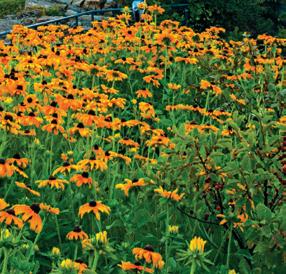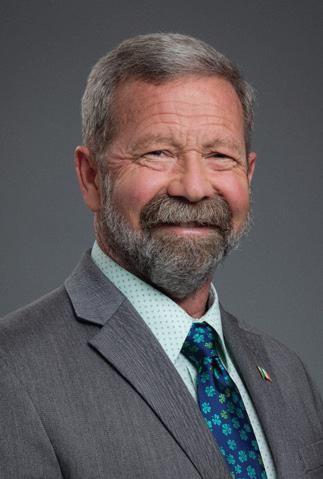Currents
ANZA ELECTRIC JANUARY 2024


ANZA ELECTRIC JANUARY 2024

Elakha Alliance is on a quest to restore sea otters to the Oregon Coast Page 12





From the rich maritime heritage of whaling towns to quaint island villages and grand seaside mansions of the Gilded Age, our small, comfortable ships can take you to the heart of New England’s most treasured destinations. Be welcomed back to your home away from home, where you can delight in the warm camaraderie of fellow guests and crew.








































By Maura Giles
Electricity plays an essential role in everyday life.
It powers our homes, offices, hospitals and schools. We depend on it to keep us warm in the winter (and cool in the summer), charge our phones and binge our favorite TV shows. If the power goes out, even briefly, our lives can be disrupted.
The system that delivers your electricity is often described as the most complex machine in the world, and it’s known as the electric grid.
What makes it so complex? We all use different amounts of electricity throughout the day, so the supply and demand for electricity constantly changes. For example, we typically use more electricity in the mornings when we start our days, and in the evenings when we cook dinner and use appliances. Severe weather and other factors also impact how much electricity we need.
The challenge for electric providers is to plan for, produce and purchase enough electricity so it’s available exactly when we need it. Too much or too little electricity in one place can cause problems. To make sure the whole system stays balanced, the electric grid must adjust in real time to changes and unforeseen events.
At its core, the electric grid is a network of power lines, transformers, substations and other infrastructure that spans the country. But it’s not just a singular system. It’s divided into three major interconnected grids: the Eastern Interconnection, the Western Interconnection and the Electric Reliability Council of Texas. These grids operate independently but are linked to allow electricity to be transferred between regions when backup support is required.
Within the three regions are seven balancing authorities, known as independent system operators or regional transmission organizations. They monitor the grid, signaling to power plants when more electricity is needed to
maintain a balanced electrical flow. ISOs and RTOs are like traffic controllers for electricity.
The journey of electricity begins at power plants. Power plants can be thought of as factories that make electricity using various energy sources, such as natural gas, solar, wind and nuclear energy. Across the U.S., more than 11,000 power plants deliver electricity to the grid.
Anza Electric Cooperative receives power from our generation and transmission co-op, Arizona G&T Cooperatives. We work closely with Arizona G&T to provide electricity at the lowest cost possible. Being part of a G&T benefits members like you by placing ownership and control in the hands of your co-op, prioritizing affordability and reliability, supporting local economic development and fostering a sense of community.
To get the electricity from power plants to you, we need a transportation system.
High-voltage transmission lines act as the highways for electricity, transporting power across long distances. These lines are supported by massive towers and travel through vast landscapes, connecting power plants to electric substations.
Substations are like pit stops along the highway, where the voltage of electricity is adjusted. They play a crucial role in managing power flow and ensuring electricity is safe for use in homes and businesses.
Once the electricity is reduced to the correct voltage, it travels through distribution power lines, like the ones you typically see on the side of the road. Distribution lines carry electricity from substations to homes, schools and businesses. Distribution transformers, which look like metal buckets on the tops of power poles or large green boxes on the ground, further reduce the voltage to levels suitable for household appliances and electronic devices.
After traveling through transformers, electricity reaches you— to power everyday life.
We’re proud to be your local, trusted energy provider. From the time it’s created to the time it’s used, electricity travels great distances to be available at the flip of a switch. That’s what makes the electric grid our nation’s most complex machine—and one of our nation’s greatest achievements. n
Energy Star windows typically have high U-factors, a measurement of how well they insulate. Get multiple quotes for any home improvement project, including windows, and be on the lookout for rebates from utilities, state programs and the federal government.
If you aren’t buying new windows right away, consider steppingstones such as adding weatherstripping, caulking gaps and using thermal drapes.
Just like you don’t want your heated and cooled air to leak outdoors, you don’t want your air leaking into parts of the house where you never go.
If you have ductwork in an attic, crawlspace or other unairconditioned or heated area, the ducts could have leaks that increase your energy bill. According to the Department of Energy, 20% to 30% of the air moved through ducts is lost to leakage.
Hire a professional to seal your ducts, or seal them yourself with metal tape or duct mastic specifically designed for the job. Do not use duct tape, which will dry out and lose adhesion.
So far, we’ve covered three ways to keep your heated and cooled air where you want it. It turns out, how you heat or cool the air is also important.
If you’re willing to replace your furnace, or the unit is 10-plus years old, a heat pump is an efficient home heating and cooling upgrade. It can reduce heating costs by as much as 50% compared to electric resistance heating, according to the Department of Energy.
A heat pump works similarly to an air conditioner in reverse. It uses a refrigerant to pull heat energy out of the air outdoors, then moves it indoors and blows the heat into your living areas.
Also consider a heat pump water heater, which has all the same advantages but heats water rather than air.
If a heater turns on, but nobody is there to hear it, does it make a noise? One thing we know is that it would impact your energy bill.

Before starting a project, it is important to take a step back and consider, “What will make the biggest impact?” This means knowing how efficient your house is and where the energy use is going.
A home energy assessment looks for air leaks, insufficient insulation, energy-hog appliances or other issues, and evaluates your total energy use. Conducting a home energy assessment lets you know where any inefficiencies in your house are, giving you a blueprint for fixing them.
Many utilities offer assessment programs, and the Department of Energy offers guides on assessments— including tips for a do-it-yourself assessment—at www.energy.gov/energysaver/home-energy-assessments.
Both programmable and smart thermostats help people save energy by changing the temperature throughout the day. You can save 10% on energy bills by turning back the thermostat 10% to 15% for eight hours a day, according to the Department of Energy.
Whether that means heating or cooling less during the day while you’re at work or turning things down while you’re sleeping, a programmable thermostat ensures you’re only heating and cooling the air you feel. n
By Chiara Profenna
Soaring above a golden expanse of wheat, drones whiz through the air, not just counting crops but playing a pivotal role in detecting disease and sowing the seeds of tomorrow’s harvest.
In the heart of rural America, a technological revolution continues. A new future of machinery, automation and cutting-edge technology is touching down in our communities.
As our world undergoes this transformation, there is a pressing need for a workforce equipped to navigate this new frontier. Enter STEM education, where science, technology, engineering and math are the soil in which the next generation matures to take over this ever-changing landscape.
As the needs of the workforce evolve, education practices are shifting to meet the latest demands. The most recent is a surge in STEM careers in rural areas. According to the U.S. Bureau of Labor Statistics, STEM
occupations grew 79% in the past 30 years. Rural communities feel this change more than most, according to STEM professionals across the Pacific Northwest.
“All jobs in the workforce right now basically require some level of STEM literacy,” says Holly Bringman, coordinator for the Apple STEM Network in North Central Washington. “And that’s one of the critical shifts. How we live and work in general is more technical.”
The Apple STEM Network is just one of the many organizations creating partnerships across the education system— improving pathways for students seeking STEM careers in rural communities.
From Classrooms to Warehouses STEM education in rural communities reflects this change in workforce demand, with more schools and resources focused on finding ways to bring STEM to students.
One such development is careerconnected learning, a framework
emphasizing career awareness, exploration and training that directly reflects professional and industry expectations. By collaborating with industry partners, educational STEM hubs and schools can offer students unique internships and work-study programs.
In a collaboration among the Central Oregon STEM Hub, High Desert Education Service District and KEITH Manufacturing Co. in Madras, Oregon, high school students interned on the floor of the KEITH warehouse during the summer.
“This summer was the first year that we’re actually able to give the students hands-on experience,” says Mike Feigner, KEITH’s plant manager. “They came in here every day and built our product. And they walked away knowing that they can do these skills and that they can work in a place like this.”
The program was deemed a success in its inaugural year, with one student intern receiving a job offer at the end of

Students and educators explore STEM learning resources to support more diverse forms of teaching outside of the classroom.
The Oregon Coast, with its rugged cliffs and abundant marine life, holds a special place in the hearts of locals and visitors. Yet, it's been missing a critical piece of its ecological puzzle for decades: the sea otter. Elakha Alliance, a dedicated advocacy group, wants to complete that puzzle.
Since 2018, the nonprofit has aspired to restore the sea otter population to the Oregon Coast through advocacy, scientific research and educational awareness.
The alliance’s history goes back about 20 years, when David Hatch questioned the return of sea otters. At the time, David was the Oregon Coast Indian Tribes’ representative on the Oregon Ocean Policy Advisory Council.
One of the council’s staff members was Bob Bailey, an employee at the Department of Land Conservation and Development. During their time on the council, David and Bob became acquainted through their mutual passion for coastal conservation. During one of their conversations, David mentioned sea otters.
“He had built a small boat,” Bob says. “And in the process of building that small boat, was looking for a name for it. He
ran across the word elakha, which in the Chinook trade jargon means sea otter. He ended up naming his little boat ‘The Elakha.’ But it also set him on a path toward understanding and coming to realize sea otters had once been part of the lives of Indigenous people all along the Oregon Coast and beyond.”
David began sharing information about sea otters and seeking ways to create change. Through tribal and non-Indigenous connections, he gathered resources to support his project.
“Dave was out spreading the gospel, as it were, about returning sea otters,” Bob says.
Many years later, in 2016, Bob recalled this encounter. He reached out to David to see what had become of the sea otters.
“I didn't hear back from him and came to find out some weeks later that he had died quite tragically and suddenly that particular week,” Bob says. “[It] was devastating, of course, to his friends and family and all of us.”
Not wanting David’s life’s work to die with him, Bob took up David's mission and formed Elakha Alliance.
The organization was incorporated in 2018. Since then, it has supported many steppingstones in the long and arduous path of species reintroduction.










Graham Cracker Picnic Mix
¼ cup vegetable oil
¼ cup sugar
5 to 6 drops pink neon liquid food color
½ cup unpopped popcorn kernels
1 package mini pastel marshmallows
1 cup bear-shaped graham crackers
1 package white fudge-covered pretzels
1 cup mini cookies
In a large pot over medium heat, stir oil, sugar and food coloring. Stir in the popcorn kernels. Cover. Cook until popcorn begins to pop. Shake pot over heat until popping slows.
Remove pan from heat. Pour popcorn into a large bowl. Add marshmallows, graham crackers, pretzels and cookies. Toss lightly.
I am learning the technique of Swedish huck weaving and am having a difficult time trying to find huck weave materials in Alaska. If you have any huck weave materials that you would be interested in getting rid of, I would love to have them. Thank you.
Nancy Riley P.O. Box 57030 North Pole, AK 99705
I would appreciate unwanted jewelry—old, new or broken. Also, unmatched earrings and unwanted watches. Thank you.
Carol Semenko 145 Chukar Lane Alturas, CA 96101
I am requesting large—about 2 inches—wooden thread spools. A friend carves faces into them. Thank you.
Barbara Cadwell
950 Pomona St., Unit 228 The Dalles, OR 97058 bpcadwell228@gmail.com
I have a flat rate USPS box stuffed full of wool, yarn, needles and other knitting accessories that I would like to give away. If you are interested, contact me by email, and I will be happy to mail them to you free of charge.
Pat Sunday
7096 N.E. Stonewater St. Hillsboro, OR 97124-7282 suncia@icloud.com
My mother will be 94 years young in January. I know she would be happy to receive birthday cards. Mail to: Mary Ann Cline, 2221 Oak St., Apt. 329, Forest Grove, OR 97116. Thank you.
Carol Davis Vernonia, Oregon
My mother, Gail Simmons, turns 80 in January. She has been a nurse since I was a child, and she’s still a nurse in the same assisted living facility after more than 30 years. She is a very caring nurse for the elderly, ensuring her residents receive the best care possible while working through the pandemic. She is what you would expect in a nurse—always giving instead of receiving. If you asked her why she still works today, she would tell you it’s in her DNA and it’s what she lives for. I would love to see her face glowing with pride receiving birthday wishes and words of encouragement. Thank you for your letters and cards in advance. Send to: Gail Simmons, 1699 N. Terry St, Space 155, Eugene, OR 97402.
Robert Shafer Heppner, Oregon
Have a Happy New Year!
My dear friend turns 91 in January. She is a retired school teacher with a strong sense of humor and amazing stories to share. Her birthday would be so special if you could send cards. Thank you in advance. Send to: F. Hart c/o 46383 Brahman Way, Pendleton, OR 97801.
Sandra Pendleton, Oregon
Looking for images and stories of Oregon Army and Navy airfields directly before and during World War II that were used by the military. Will pay postage and return images. Needed for academic research.
Andi Journey P.O. Box 226 Crescent, OR 97733
If anyone is interested in metal pull tabs off cans, we have bags that can be sent to you. Contact me, and I’ll get them on the way.
Peggy Timms 19 Cedar Drive Hermiston, OR 97838
North Powder Charter School is accepting donations of new or used playing cards and dice. These will be used to create math games for students and their families. Items can be mailed or delivered before March 1 to: NPCS, 333 G St., North Powder, OR 97867.
Allie Scott North Powder, Oregon
Send your request (no attachments) to readerexchange@ ruralite.org or mail to Reader Exchange, 5625 NE Elam Young Parkway, Suite 100, Hillsboro, OR 97124. Fill in the subject line with Reader Exchange.
Acceptance, scheduling and editing are at the editor’s discretion. Single requests only, please. No duplicates.
Submissions are handled first-come, first-served as space allows. We cannot honor every request.
Please affirm you have authorization from all appropriate parties before submitting. By submitting, you indemnify Reader Exchange, Pioneer Utility Resources Inc., its officers, directors, employees, utility clients and insurers from all legal liability incurred by the publication of information.
We no longer accept pen pal requests. You may submit a pen pal request as a Marketplace ad (pricing applies).
When submitting a milestone request, please send it at least two months before the milestone.
Phone numbers are not published. Email addresses are if part of the ad, but you must include a postal address.
Requests must include the name and address of the electric utility that provides your magazine.

Hop into history at the Hagerman Fossil Beds in Southern Idaho, and experience one of the world’s largest fossil deposits from the Pliocene epoch—roughly 3 to 5 million years ago.
In 1928, a local rancher named Elmer Cook saw fossil deposits eroding along the Snake River. He contacted the United States Geological Survey, which in turn notified the Smithsonian Institution. The Smithsonian conducted four expeditions between 1929 and 1934.
The Smithsonian digs unearthed more than 200 fossils of Equus simplicidens, a predecessor of horses, that more closely resembled zebras. Finding so many fossils together helped researchers realize these horses were likely pack animals. The digs also found previously unfound species such as Platygonus pearcei, an early javelina.
The Thousand Springs Visitor Center opened in 2022, and is a great place to learn about a century of research at the site. The center has exhibits featuring fossils and the knowledge gained at the site, as well as ranger talks to guide visitors through the information.
Until March, the visitor center is open 9 a.m. to 3 p.m. Friday through Sunday. To plan your trip, call 208-933-4105 or visit www.nps.gov/hafo.

My heart is heavy.
One of the true blessings of writing a column is the opportunity to share with you, my readers, not only what I see but what is on my heart. The two are often interconnected. As trite as it sounds, I feel like we are family.
In the wake of the most recent war atrocities, it’s challenging to keep my attention on things like photography and positive storytelling. Yet, even as I wade through the

emotions of these conflicts, I am reminded what a lifelong gift photography is, distracting me from deep and painful events while acting as a vehicle to share what I see and feel. For this, I am forever grateful.
Armed with a purpose, photography has always been a powerful communication tool. With it, we can shine light in dark places or quietly applaud acts of love and goodness. I believe both are necessary. While I truly admire the courage of my friends who risk their lives to show us the injustices and atrocities of war, I have chosen to celebrate light and those who reflect it.
Where there is light, there is hope. The new year is the perfect time to talk about seeing and being light. Whether
literal or metaphoric, light reveals and heals. Each of us chooses how we use light. With our cameras, as with our words, we can choose to focus on the good and lovely in our world or dwell on the dark, ugly and evil.
I attended a seminar where the speaker reminded his audience of the difference between a thermometer and a thermostat. One reads the temperature, and the other changes it, he challenged.
The late Agnes Baker Pilgrim—also known as Grandma Aggie, a Native American spiritual elder I wrote about a few years ago— said she talked to water, thanking it often. She insisted water hears us. I think light is similar. I know it has a voice. n
Show me the goodness of light, as it falls on mountains, fields, streams, rooftops, bedsheets or kitchen sinks. Or, as it springs forth from the heart in acts of kindness.
Email your best image (just one, please) with caption information, including an explanation of how it affects you, to GPH@pur.coop. We may share submissions on our website and social media channels.





Amemorable
beach moment: You’re basking in the warm sun, toes in the sand, letting the gentle turn of the foam-capped waves lull you into a state of complete relaxation. As your eyes scan the endless horizon of blue on blue, you’re rewarded with a pod of dolphins making their way across the sea.


There’s no denying their signature shape as they leap from the water. If you don’t see anything else extraordinary the rest of day, you can take solace knowing you’ve witnessed one of nature’s most playful and human-like creatures in their natural habitat.


Why not re-create that special moment with our Balinese Dolphin Pendant? We’ve captured two dolphins midjump in sterling silver crafted in the Balinese style. Tucked between these beloved sea mammals is a full carat of shimmering blue topaz. Made by some of Indonesia’s finest artisans, this pendant is an absolute steal at JUST $29! That’s what we call our Stauer IMPOSSIBLE PRICE!
Nothing captures the shimmering color of the ocean in the midday sun like blue topaz. With its sparkling, clear blue color and high reflective index, blue topaz is one of the world’s top-selling gemstones. The Gemological Institute of America lauds topaz for its hardness, noting that blue topaz is known for its intense color that’s better than aquamarine. With this special price, you can score quite the catch.

Satisfaction guaranteed or your money back. Enjoy the Balinese Dolphin Pendant for 30 days. If it doesn’t pass the test swimmingly, send it back for a full refund of the item price.
Limited reserves. This pendant is already one of our best sellers this year. A full carat of genuine blue topaz set in .925 sterling silver for this price is as rare as a dolphin sighting. We cannot guarantee availability for long. Call today! This offer is limited to the first 1,900 responders to this ad!
Jewelry Specifications:
• Made in Indonesia
• Blue topaz and .925 sterling silver

Balinese Dolphin Pendant (1 carat) $299 $29* + S&P Save $270
*Special price only for customers using the offer code.







One carat of shimmering blue topaz set in sterling silver for $29
What Stauer Clients Are Saying About Our Topaz

“Just lovely! Would recommend it as a purchase. Thank you STAUER.” — Mary L.




Board of Directors
Ryall Stewart, President
Stephan Lauzier, Vice President
Chilli Ainsworth, Secretary
Harold Burdick, Treasurer
Steven Silkotch
Hope Adams
Diane Sieker
General Manager
Kevin Short
P.O. Box 391909
Anza, CA 92539
Phone: 951-763-4333
Fax: 951-763-5297 aec@anzaelectric.org www.anzaelectric.org
An interesting part of our economy involves the timing of our purchases. Without getting too involved in the finer points of marketing, we can pay more or less for a product based on many factors, such as seasonal supply, higher demand for some products and scarcity of raw materials. Our cooperative has experienced a significant increase in material costs over the last several months due to many of these market factors.
Our largest cost in our day-to-day budget is the purchase of energy for our members. This single line item represents about half of our annual operating costs. When we buy energy, most of it is under long-term contracts. These contracts guarantee pricing for us and help control costs. However, we are also regularly in the market to buy energy as we need it. This exposes us to higher costs depending on the time of year and the time of day.
Electric energy is a unique commodity. It needs to be consumed at the exact time that it is produced. This requires balancing supply with load around the clock, every day of the year. Major supply and demand imbalances can create serious system problems that must be avoided to maintain power quality and stability.
Higher demand for energy at certain times of day—such as late afternoon on hot summer days—creates market conditions that push hourly prices much higher than at other times. During these high demand hours, electricity can cost as much as 50-100 times as much as during off-peak demand times. While we do not charge our members higher prices during peak times, the overall cost for energy is affected by these peak time costs.
When we buy energy is 100% dependent upon when our members demand it. Therefore, when we buy energy during peak demand times, we pay more. This affects our total energy cost and pushes the rates we charge higher.

h January 1-New Years Day, office
h February 19-Presidents Day,
It matters when we use energy. Please help us control energy costs by reducing your demand during the peak demand hours of 4 to 9 p.m.
